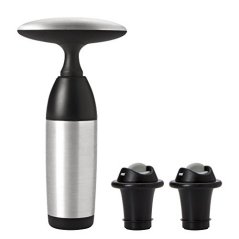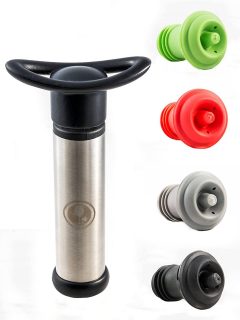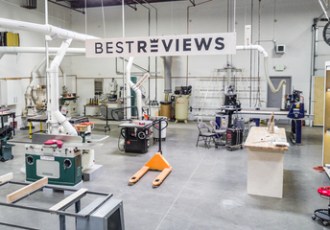BestReviews is reader-supported and may earn an affiliate commission. Details

For wine drinkers who want a clear indication of when the bottle is sufficiently sealed.
For wine drinkers who want a clear indication of when the bottle is sufficiently sealed.
Keeps wine fresh for about a week. Rubber stoppers are made well and should last. Easy to operate the pump and remove the stoppers. Emits a click to tell you when you need to stop pumping. These bottle stoppers fit many types of bottles.
According to some customers, it takes quite a few pumps to get a good seal.

A compact vacuum-sealing wine stopper for preserving wine flavor.
A compact vacuum-sealing wine stopper for preserving wine flavor.
This food-grade silicone wine stopper preserves wine and prevents spills and leaks. Fits snugly on most wine bottles. Features a convenient date-tracking dial. Easy to use and does not strain hands. This stopper can preserve wine for up to fifteen days.
A few customers noted that the stopper only stayed secure for a few days.

A wine preserver pump that's suitable for those with arthritis or carpal tunnel syndrome.
A wine preserver pump that's suitable for those with arthritis or carpal tunnel syndrome.
Handle is ergonomically designed with non-slip rubber. Doesn’t require a lot of pumps to get a good seal. Can preserve wine freshness for 4 or 5 days. Instruction video on the manufacturer’s product page is helpful.
Unlike a well-known competitor, pump doesn’t make a clicking sound to indicate when it’s finished.

An effective vacuum wine preserver with an attractive stainless steel finish.
An effective vacuum wine preserver with an attractive stainless steel finish.
Because this wine preserver is made of stainless steel, it will last longer than wine preservers made of plastic. It has an easy-to-use date marker that lets you know when you opened the bottle and it can keep wine fresh for up to a week.
Some complaints about stoppers not forming a complete vacuum seal.

A small and sturdy vacuum pump that can keep most opened wine fresh for up to two weeks.
A small and sturdy vacuum pump that can keep most opened wine fresh for up to two weeks.
Stainless steel design offers durability. Small, lightweight, and easy to use. Made of high-quality and environmentally friendly materials. Includes four colorful stoppers, which also prevent any wine leakage.
Slightly more expensive than most simple vacuum pumps.

We recommend these products based on an intensive research process that's designed to cut through the noise and find the top products in this space. Guided by experts, we spend hours looking into the factors that matter, to bring you these selections.

When it comes to some drinks, breaking the seal or popping the top means the clock starts counting down toward expiration. That window is especially small with wine, which can improve mightily when it’s allowed to breathe, only to turn acidic and undrinkable if it’s not consumed within a few days.
Once the wine bottle is unsealed, oxygen gets in and slowly starts to change the flavor of the wine. You don’t want to spend a lot of money on wine to only enjoy some of it. Wine preservers are a great way to preserve your bottles. With a wine preserver, you can open a bottle, enjoy as much or as little as you desire, and then keep what’s left fresh. Simple wine preservers can increase the longevity of wine from a few days to a week, while more advanced technologies are geared toward preserving finer wines for even longer.
Our buying guide has everything you need to consider when shopping for wine preservers. For our five favorite products on the market, see the matrix above.

There are three common wine preservation techniques, which all aim to keep oxygen out of the wine bottle.
Before buying a wine preserver, it’s important to note that not all wine oxidizes and expires at the same rate. Light-bodied and sweet whites, such as Riesling or Pinot Grigio, have a shelf life of about five or six days once opened. Full-bodied whites and most reds will last three to five days. So, if you have a penchant for Moscato, then you’ll have more time without the need of a wine preserver than someone who exclusively drinks Cabernet, for example.
Most basic wine preservers come with one or two stoppers, which is ideal if you have friends over and open one white and one red. However, two stoppers may not be enough, especially if you like pairing specific wines to specific meals. There is no point in getting a vacuum pump if you don’t have enough stoppers to go around. Look for wine preservers that include four to eight stoppers.

You’ll need something to open the wine bottle before you close it. Some companies package wine openers with their wine preservers, including electric openers that easily uncork any bottle in seconds.
Similarly, wine preservers may come with an aerator. These devices fit into the top of the bottle and allow more air to enter the bottle in order for the wine to reach its optimal flavor.
Most stoppers are black or gray. However, some wine preservers come with a variety pack of colored stoppers to liven up your wine collection and help you keep track of when you opened each bottle.
If you’re looking for a basic manual vacuum pump wine preserver, you won’t need to spend much money.
For under $20, you can find a wide range of vacuum pumps with any number of stoppers. The pumps may vary in size and weight, but most are similarly effective. Your resealed bottle of wine should last at least a week with these pumps. You’ll also find aerosol cans for inserting inert preservation gases in this price range.
Between $20 and $100, you’ll find electric pumps that come as part of a larger collection of wine tools, including electric openers and aerators.
For $100 to $300, you’ll find advanced wine preservation systems. These devices, which let you enjoy wine without ever uncorking it, are for serious wine connoisseurs who own high-end bottles.


Q. How long will wine last when I use a wine preserver?
A. There is no set answer as a wine’s lifespan relies on a number of factors. Wine preservers often claim they will preserve any wine for a certain number of days, but in reality it differs with every wine. Wine type, how it’s stored, how much is left, and the quality of the seal all play a part. That said, vacuum pumps and sprays ideally keep wine fresh for one week.
Q. Will I need additional wine stoppers?
A. Each vacuum pump comes with at least one stopper, but you may need more. Before buying a wine preserver, check whether or not the company sells stoppers separately because not all do. One company’s pump may not match another’s stopper.
Q. Can a vacuum seal leak?
A. The sealed stopper should not leak. However, storing a wine bottle on its side increases the maximum surface area of wine that comes into contact with air in the bottle, meaning it will oxidize more quickly. Try to store wine upright.
Q. Do wine preservers work for sparkling wine or Champagne?
A. No. Sparkling wines like Champagne lose their carbonation after opening, and removing the air from the bottle and sealing it will not bring the carbonation back. However, some companies do offer sparkling-specific preservation systems that pump carbon dioxide back into an opened bottle.
Get emails you’ll love.
Learn about the products you’re wondering if you should buy and get advice on using your latest purchases.
